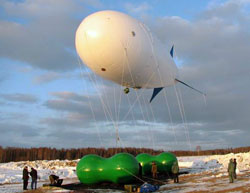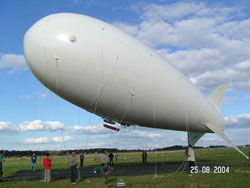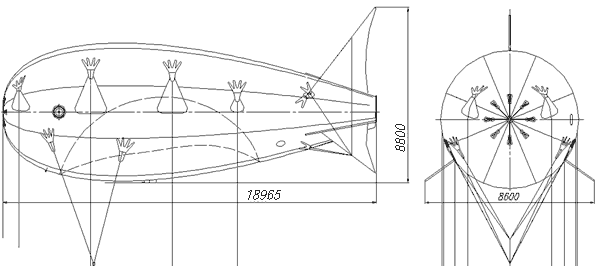|
"Рысь" привязной аэростат малого объема
|
Аэростат способен увеличить эффективность работы и радиус действия современных переносных радаров. Комплекс может быть оснащен гиростабилизированной камерой высокого разрешения и инфракрасной камерой для использования его в качестве мощного средства наблюдения за приграничными территориями с радиусом действия 70-80 км. Аэростат может также использоватся для раннего обнаружения лесных пожаров, наблюдения за территориальными водами, обнаружения браконьеров и контрабандистов и т.д.
Аэростат может использоватся в самых различных областях, таких как:
Коммуникации
Реклама
Наблюдение
Научные исследования
Воздушная фотография, телевизионная съемка
|
| |
Аэростат Au-27 удерживается в воздухе с помощью специального канат-кабеля состоящего из прочного волокна типа Kevlar и трех медных жил, которые позволяют передавать на борт аэростата электроэнергию мощностью до 3 Квт. Этой энергии достаточно для постоянной работы бортового оборудования и полезной нагрузки. Основной функцией бортового оборудования является автоматическое поддержание избыточного давленияв оболочке аэростата для чего служат баллонет , воздушный клапан и вентилятор. Полезный груз обычно крепится непосредственно к оболочке.
Оболочка аэростатов изготовлена из специально разработанного многослойного материала на основе полиэстера высокой прочности с уникальной способностью не пропускать гелий. Внешний слой материала защищает оболочку от воздействия сложных погодных условий и не подвержен обледенению. Срок службы оболочки - 5-6 лет . При изготовлении оболочки используется сварка токами высокой частоты, что обеспечивает высокую прочность и качество швов. Все вышеуказанные факторы позволяют Au-27 оставаться в воздухе без пополнения гелием до 20 дней.
Аэростаты Au-27 весьма экономичны в эксплуатации, так как имеют незначительную утечку гелия и небольшое энергопотребление. Для наполнения оболочки и первого подъема аэростата требуется 4-6 человек. Регулярные операции, в том числе инспекция и повторное наполнение, требуют 1-2 человек.
Для стационарного использования аэростатов создана специальная причальная система. Эта причальная система способна удерживать аэростат при скорости ветра до 30 м/с. Во время краткосрочных полетов в отдаленных районах возможно использовать аэростат без причальной системы. В таком случае достаточно традиционного наземного бивака с 8 якорями. Бивак можно использовать при скорости ветра до 27 м/с.
|
| |
| | |  | | |  | | |
 |
Технические характеристики аэростата Аu-27 «Рысь»
| Раскройный объем оболочки, м3
| 450
| Длина, м
| 19
| Высота, м
| 8,8
| Максимальная скорость ветра, м/с:
- на удерживающем устройстве
- на бивачной площадке
- на рабочей высоте
|
30
15
25
| Продолжительность стоянки на рабочей высоте, сутки
| 15
| Максимальная высота подъема*, м
| 1000
| Полезная нагрузка, кг
| 60 - 150
| Рабочая высота** (не менее) при массе полезной нагрузки 80 кг
| 700 м
| Максимальная мощность полезной нагрузки, обеспечиваемая по канат-кабелю с земли, кВт
| 2,5
| Вариант исполнения комплекса (мобильный/стационарный)
| моб./ст.
|
**) Рабочая высота стоянки привязного аэростата, которая обеспечивается для данной массы полезной нагрузки при максимальной скорости ветра на рабочей высоте, указанной в таблице, в температурном диапазоне окружающей среды ± 40 С.
Назад
|
|


